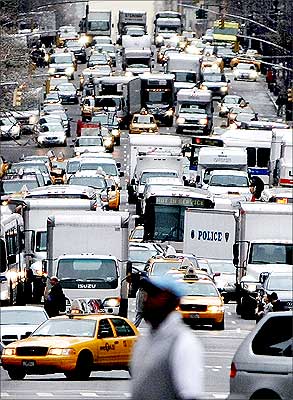 New York mayor Michael Bloomberg is trying again to decongest the Manhattan after his efforts to levy a congestion charge for the city were stalled. Bloomberg's latest scheme is to carve a 10 km path through the centre of the Big Apple and turn it a pedestrian zone on Saturdays.
New York mayor Michael Bloomberg is trying again to decongest the Manhattan after his efforts to levy a congestion charge for the city were stalled. Bloomberg's latest scheme is to carve a 10 km path through the centre of the Big Apple and turn it a pedestrian zone on Saturdays.
The proposal is slated to be tested out on three Saturdays in August this year, when a route linking the Brooklyn Bridge to the Upper East Side and Central Park, will be a no-traffic zone, unleashing a deluge of walking, cycling and street life on New York's congested roads.
The project titled 'Summer Streets,' is expected revive some of the hope lost over the city's inability to control its burgeoning traffic after Bloomberg failed in April to convince the state assembly to back his congestion levy plan.
Most of Manhattan's arterial roads are blocked by vehicular traffic for almost 12 hours a day and the hope of New Yorkers to enjoy a traffic-free city looked like a pipe dream.
Under the proposal, between 7 am and 1 pm on August 9, 16 and 23, New Yorkers will be able to feel what the island would have been like if it were not swamped by cars. The best part of the project will be the opening up of the road from Park Avenue to 72nd Street, one of the largest thoroughfares in the city. The propsed route will pass through Fourth Avenue, Lafayette Street and Centre Street linking all the spots to the cycle path crossing Brooklyn Bridge. Water stops, bike rentals, free dance classes and yoga classes are some of the attractions planned for the days.
The idea is inspired from the Ciclovía festival in Bogotá, Colombia, where every summer Sunday from 7 am to 2 pm, millions of people throng a 100 km route, spanning the city's streets.
Bogotá's example has unleashed a flood of imitators, including several in the United States like El Paso, Texas, Cambridge, Massachusetts and Chicago. Portland, Oregon will clear six miles of streets for six hours a day later this year in a similar experiment.







